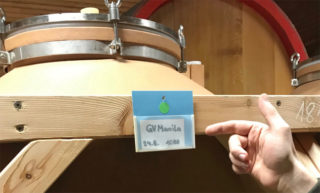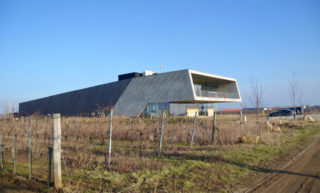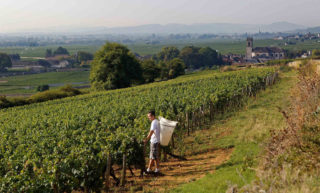Similarities and differences between two Austrian Blaufränkisch appellations
Despite the fact that Blaufränkisch is considered to be Austria’s prime black quality grape, it took a while to win me over.
Recently, some preeminent wineries from the Leithaberg and Eisenberg DAC’s, two appellations in the east of Austria, presented their soon to be released Blaufränkisch wines at an annual event, this year in Grafenegg’s castle, an hour west from Vienna. The wineries share a focus on terroir. Four of them facilitated my conversion.
For the first few years after I took up residency in Vienna, I perceived wines from Austria’s noble grape Blaufränkisch often as too astringent, too oaky, too leafy, and sometimes too tannic or too full-bodied.
My personal Blaufränkisch proselytization came almost instantaneously after I had a glass of Uwe Schiefer’s Reihburg 2011. Everything I had heard about the greatness of Blaufränkisch fell into place. The trademark acidity and the sour cherries gave it a refreshing attack, the tannins provided prefect grip, the notes of maturation in partly new oak excelled mid-palate and were subtle and well-integrated, it was herbal and spicy rather than leafy, a hint of lovely animalistic stink provided depth and it seemed to have lingered on the palate forever. To this day, the thought of it evokes an imaginary flavour sensation.
As an early budding and late ripening variety, Blaufränkisch needs a somewhat warmer, sunnier climate. Burgenland, billing itself as “the sunny side of Austria”, provides exactly that. Full ripeness of the grapes can balance their natural high acidity. Styles can vary from dark, spicy, tannic and capable of ageing to lighter, fruit-driven version. It all depends on the geographical origin and the vintner’s choices. The four vintners I spoke to may not cover the entire range, but at least a good part of it.
The Eisenberg
Along the border with Hungary in southeast Austria, stretching out from the town of Rechnitz in the north to Heiligenbrunn in the south, the Eisenberg DAC is just a narrow strip of land with around 500 hectares of vineyards. Winemaking centers on the town of Eisenberg and the eponymous hill.
Here Uwe Schiefer, one of the region’s most prominent winemakers has some of his most important vineyards. With a background in hospitality – he was a sommelier at Austria’s most illustrious restaurant Steirereck – winemaking is his second career and his biggest passion. While we tour his vineyards, he tells me about the unique location of the Eisenberg. “The kettle shaped Eisenberg only opens up to the south-southwest, protecting the vineyards from the elements relatively well.” On a clear day, the views from the rim of the kettle into the plains are vast and spectacular. The vineyards are interspersed with foresty patches that Schiefer, who doesn’t shun big words, detests. As he says, the Eisenberg used to be completely planted with vines, but after the wine scandal of the 1980s and due to the fact that vintners often didn’t have a successor, vineyards were left and soon overgrown with trees. In his wildest dreams, Schiefer vies to reestablish all the vineyards of the Eisenberg.
No lack of ambition
Schiefer is rightly proud of his icon wine from the loamy Reihburg vineyard on the lower reaches of the Eisenberg. As a matter of fact, his takes pride in all his wines, and he doesn’t lack ambition. Although rooted in the Eisenberg area, he also ventured into Mittelburgenland (an appellation north of Eisenberg) and Leithaberg. As he says, he wants to show the world he can make good Blaufränkisch in any place. And: “I want each of my wines to be the best in their category.” His Blaufränkisch Burgenland, with grapes from his vineyards in two DAC’s and labelled as a regional Burgenland appellation, is an entry-level wine that is largely served by the glass in bars and restaurant. What it may lack in complexity, it compensates with animating acidity, juicy dark fruit and some dried herbs. A very drinkable, but still interesting wine that punches above its weight. For all his wines, the grapes are hand harvested and fermented spontaneously; they aren’t chaptalized and just minimally fined and filtered or not at all.
The Prantner vineyard (left) and Christoph Wachter (right)
Erste and Große Lagen
Just like Schiefer, expressing the typical Eisenberg terroir is Christoph Wachter’s ultimate goal. With his boyish looks and his hipster cap, he doesn’t look the typical Obman (chairman) of the Eisenberg DAC, but he knows exactly what he wants. While we taste through his range of wines on the porch of his winery in Deutsch-Schützen, he tells me about his quality pyramid. At the bottom he has his base cuvée, followed by his best-selling regional wine Béla-Jóska, an Eisenberg DAC, named after two of his ancestors. Next are his village wines, labelled as Eisenberg DAC Reserve, for which the grapes need to be riper, the maturation longer (minimum two years) and the yields lower (4500 to 5000 kg/ha). At the pinnacle, in terms of quality, are Wachter’s single-vineyard wines, four in total, two each from Deutsch-Schützen and Eisenberg. As he sees it, the vineyards Reihburg, Saybritz and Szapary (all on the Eisenberg), should eventually become Große Lagen and Ratschen and Weinberg (in Deutsch-Schützen) Erste Lagen. In Burgundy that would be Grands Crus and Premiers Crus respectively. He aims to have this origin-based system rolled out in the entire appellation. But for now the appellations have two quality levels: Eisenberg DAC and Eisenberg DAC Reserve. Wachter’s wines may be a tad lighter-bodied and easier to drink than Schiefer’s, but no less tempting. His vibrant Ried Ratschen with aromas and flavours of violets, laurel, dark berries, the omnipresent dark sour cherries and a bit more body than his other single vineyard wines pushed my love for Blaufränkisch to yet a new level.
Differences and similarities
With his experience in both the Eisenberg and Leithaberg DAC, Schiefer is the right person to ask about the differences between the two appellations. Soil and climate are the main ones, he says. Whereas the Leithaberg, a range of hills on the westside of Lake Neusiedl, is known for its white marine limestone, in Eisenberg iron containing loam and blue and green slate are the distinguishing features. Both regions have a so-called Pannonian, meaning continental climate, named after the Roman province of Pannonia, which roughly overlapped with the flat Hungarian basin. The relative proximity to the Adriatic allows a waft of warm, humid air to reach the Eisenberg area. On the other had, Lake Neusiedl has a considerable influence on the temperature in the Leithaberg area. But higher up and further away from the lake cool air flows down into vineyards from the forest-covered peaks of the Leitha Range during the night, resulting in slower ripening, and thus more freshness and finesse. The Eisenberg climate, and particularly the northern part, is shaped by the Geschriebenstein Mountain (884m), a final Alpine fold on the Austro-Hungarian border that is, similarly, responsible for a large diurnal temperature range.
Herkunft
At Weinbau Straka, located at the foot of the Geschriebenstein in Rechnitz, I became most acutely aware of the local terroir, although it required a sip of their white wines. Thomas Straka, the jovial, somewhat corpulent vintner and a darling of the natural wine scene, tells me how the green slate results in higher tannins, which are good for the shelf life and stability of the wine. To balance the influence of the tannins he uses grapes that are fully ripe. The resulting salinity, smokiness and spicy herbaceousness I found in his Blaufränkisch wines, was also displayed in his ungrafted Welschriesling 33,30 (named after the parcel number), something Straka attributes to the green slate. For Straka Blaufränkisch and certainly the neutral variety Welschriesling are astonishing agents of terroir. Winemaking isn’t about primary fruit – that comes mostly from cultured yeast, he says provocatively – but about Herkunft or origin.
Heinrich - Biodynamic farming on the Leithaberg
No primary fruit
All the way up north in the Leithaberg DAC Gernot Heinrich expresses himself in a similar way. “I want to smell the soil. I don’t want to smell primary fruit.” His dislike for too much focus on primary fruit could make his wine hard to sell, but Heinrich is a man of principles. “I don’t make wine for the market, I develop the market for my wines.” With close to five-hundred thousand bottles sold annually he clearly knows how to do that.
Leithaberg
Heinrich has his winery in the town of Gols in the Neusiedlersee DAC, but over half of its vineyards are on the Leithaberg. Establishing a winery – his counts 100 hectare – is something you do only once in your life, he says. But if he were to do it again, he would choose the Leithaberg. The elevation, the southeastern exposure and the often pure, marine limestone make this area for vintners one of the most sought-after parts of Austria.
Two terroirs
Heinrich has two vineyards on the Leithaberg, Alter Berg and Edelgraben, representing the two main terroirs of the appellation. The Alter Berg is located on the much-praised marine, well draining and water retaining limestone, whereas Edelgraben has soils on top of water draining schist and gneiss, forcing the vines to root deep to find water holding layers. The last gives small-berried bunches of grapes that translate into tannic, more rustic, slightly smoky and often spicy wines. The chalky soils of the Alter Berg result in wines with a finely woven texture, and more freshness and elegance.
Heinrich’s wines, more often than Straka’s, show a trait of reduction, a feature that, if managed well, can lead to aromas of sesame, popcorn, flinty minerality or a struck match. When present, it certainly gives Heinrich’s wines some extra tension and a unique flavour profile.
The palpable origin of Straka’s wines and Heinrich’s hints of reduction, but also the clear manifestation of the two main Leithaberg terroirs added new dimensions to my appreciation of Blaufränkisch.
Circular economy
To prevent monoculture in his vineyards, Heinrich alternates rows of vines with patches of trees and herbs. Heinrich is on a constant quest to create a circular economy in his winery. Around sixty sheep provide manure, but also wool, the smell of which deters deer and is used as a slowly degrading ingredient of compost. Making his petrol guzzling tractors environmentally friendlier is one of his main challenges. For now, when time and weather permit, he takes his mountain bike to inspect his vineyards.
As a matter of fact, all four vintners mentioned here work biologically or biodynamically (not all certified) and intervene in the process of winemaking as little as possible. That is a fine balance, both in the vineyard and the cellar, which is not as easy to achieve as it may sound, but that is a different story.
Apart from the obvious similarities, the chalky Leithaberg and the loamy, ferrous Eisenberg soils lead to wines with the most pronounced difference. But apart from climate and soil, wine styles are also influenced by the vintner’s choices, which, some argue, is also part of the terroir. Either way, it makes winetasting an ever-exciting exercise, certainly when you get wines served of the quality level and origin expression as those of Straka, Heinrich, Schiefer and Wachter-Wiesler. Although I am all too aware that there are other formidable Blaufränkisch vintners, these four are the ones within the Leithaberg and Eisenberg appellations whose wines in all their diversity opened my eyes to the glory of Blaufränkisch.
Weinbau Uwe Schiefer
Welgersdorf 3
7503 Welgersdorf
Austria
Weinbau Straka
Bahnhofstrasse 15
7471 Rechnitz
Austria
Weingut Wachter Wiesler
Untere Hauptstrasse 7
7471 Deutsch Schützen
Austria
Weingut Heinrich GmbH
Baumgarten 60
7122 Gols
Austria
A version of this article has been published in the December 2020 issue of Apéritif.







Comments